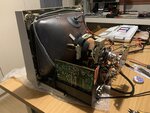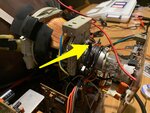fbone
Newbie level 6
Hi guys!
First of all what a great forum! Also Happy New Year to all
I need your help with my monitor which produces faint vetical lines at the left side of the screen (image attached)
 .
.
I read some great tips and info in this thread and I created my own not to hijack that one! (https://www.edaboard.com/threads/he...with-my-commodore-1084s-p-crt-monitor.393932/)
Please guide me if you suspect the culprit. I have already recapped this monitor and replaced HOT as a preventive step.
Thank you in advance!
George
First of all what a great forum! Also Happy New Year to all
I need your help with my monitor which produces faint vetical lines at the left side of the screen (image attached)
 .
.I read some great tips and info in this thread and I created my own not to hijack that one! (https://www.edaboard.com/threads/he...with-my-commodore-1084s-p-crt-monitor.393932/)
Please guide me if you suspect the culprit. I have already recapped this monitor and replaced HOT as a preventive step.
Thank you in advance!
George




